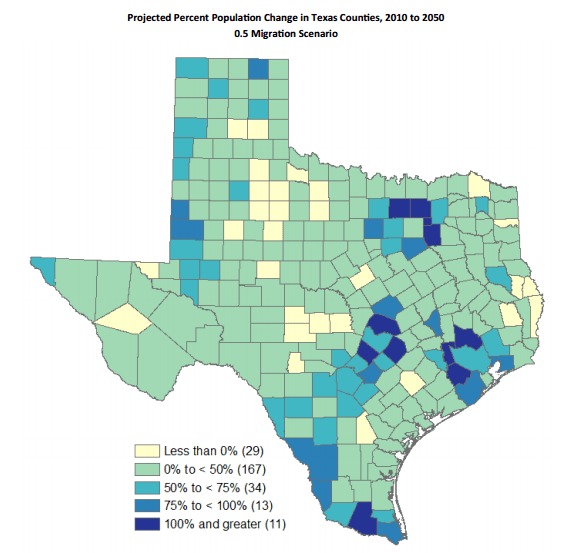The population of Texas could double by 2050, says a new report released by the Office of the State Demographer. This would be the result if migration patterns continue at the same pace they have been growing during the 2000-2010 decade.
The report, Texas Population Projections 2010 to 2050, highlights a population explosion that may well occur over the next 45 years – those individuals aged 14 and under would nearly double from 5.7 million in 2010 to 10.2 million in 2050. The 15-64 demographic would swell from 16.8 million to 34.7 million, and the senior 65-and-over demographic would jump from 2.6 million to 9.4 million. In total, Texas population would swell to 54.4 million, based on immigration and people moving from other U.S. states.
The report predicted Hispanic population to surpass Anglo population by 2020, increasing to nearly 2.3 times its size in 2010 to 21.5 million by 2050. By 2042, Hispanic population is expected to become the majority of the state’s total population. Texas is the second most populous state in the nation behind California where, by contrast, Hispanic population already overtook white population in 2014, which Breitbart News reported.
Second to Hispanic growth was Asian American listed as Non-Hispanic Other. The report projected a population of nearly 3.7 million by 2050, which would reflect a growth rate of more than 2.5 times the 2010 population. Black population is anticipated to rise at a steady pace, reaching nearly 4.1 million by 2050. White population, however, is predicted to grow at a much slower pace to reach 11.8 million in 2028 and then decline to 11.3 million by 2050.
Much of this population growth is expected to come from the large urban counties – Harris, Dallas, Tarrant, Bexas, and Travis — with a projected combined population increase of 5.6 million up to 2050. The report suggests that significant growth will emanate from outlying suburban counties surrounding these large urban counties.
The top ten “suburban counties” are Hays, Williamson, Fort Bend, Collin, Kaufman, Denton, Montgomery, Rockwall, Waller, and Hidalgo. The last is not actually a suburban county but is experiencing a similar growth pattern, according to the report. These counties are expected to more than double their populations, adding a total population of over 4.3 million or 28 percent of the total state population change during the period.
The report anticipates that Dallas County “is projected to grow at a slower pace, experiencing a growth rate of 40 percent between 2010 and 2050” while counties with rapid growth are “along the southern border and select counties in the Panhandle region.” According to the report, population in a few West and East Texas counties will decline.
The Austin American-Statesman commented that while America is aging “and so is Texas, but the Lone Star State’s continued draw to younger people from other states and abroad has given, and could continue to give, the state a younger complexion than other states. But that depends on continued migration to Texas from other states — which Texas politicians like to brag about — and on continued immigration, both legal and illegal, from abroad, which is politically fraught with controversy.”
The Statesman spoke to DC think-tanker William Frey from the Brookings Institution, who was not totally on board with the report’s projections. He said it was unlikely that Texas would be able to sustain the growth rate it has experienced so far this century, which benefited from a strong economy that was largely unbattered by the recession and the highest net migration — the number of people moving in from other states minus the number of people leaving the state — of any state for every year since July 2004. Frey also said Texas got a healthy one-time population bump from people leaving Louisiana after 2005’s Hurricane Katrina.
Houston’s job market ranked the fastest growing in the nation according to a report released by CareerBuilder and Economic Modeling Specialists International that also tracked growth between 2010 and 2013, which Breitbart Texas reported last summer. Behind Houston, Dallas was in second place. Austin ranked fifth.
Breitbart Texas also reported that the state capitol, Austin, is the fastest growing large city in the United States in the post-recession period of 2010 to 2013, according to a Census Bureau report. Austin’s population jumped by 12 percent, higher than any other large American city. Meanwhile, Fort Worth grew 7 percent, San Antonio 6.1 percent, Dallas 5 percent, Houston4.6 percent, and El Paso 3.9 percent.
Follow Merrill Hope, a member of the original Breitbart Texas team, on Twitter @OutOfTheBoxMom.

COMMENTS
Please let us know if you're having issues with commenting.